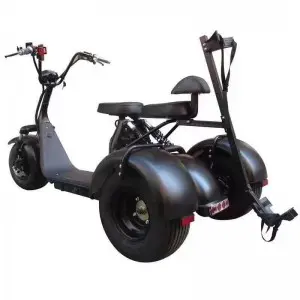Although electric motorcycles and electric vehicles are both electric-driven means of transportation, there are certain differences in terms of definition, appearance and structure, performance and characteristics, market and applications. With the development of science and technology and the improvement of people’s living standards, electric vehicles have gradually become one of the important means of transportation for people to travel. However, in the market, the names and definitions of electric motorcycles and electric vehicles are sometimes confusing. This article will detail the differences between electric motorcycles and electric vehicles to help you better understand these two modes of transportation.
The first is the definition and classification; an electric motorcycle is a motorcycle driven by electricity, usually using an electric motor instead of a traditional internal combustion engine. The performance indicators of electric motorcycles such as speed, acceleration and driving distance are similar to traditional fuel motorcycles, but their power sources are different. According to relevant national regulations, electric motorcycles belong to the category of motor vehicles and require registration, driver’s license and other procedures.
Electric vehicles usually refer to vehicles powered by electricity, also known as electric vehicles. Compared with traditional fuel vehicles, electric vehicles have different power systems, transmission systems, and body structures. According to relevant national regulations, electric vehicles also belong to the category of motor vehicles and require registration, driver’s license and other procedures. However, there are many types of electric vehicles, including pure electric vehicles, hybrid vehicles, and hydrogen fuel cell vehicles.
The second is the appearance and structure; the appearance and structure of electric motorcycles are similar to traditional fuel motorcycles. They usually adopt a two-wheel or three-wheel design and have high maneuverability and flexibility. The body materials of electric motorcycles generally use metal and composite materials, and the body structure is relatively simple. The battery of an electric motorcycle is usually installed under the body or at the rear, and the electric motor is installed in the wheel hub or on the drive shaft.
The appearance and structure of electric vehicles are similar to traditional fuel vehicles. They usually adopt a four-wheel design and have better comfort and stability. The body materials of electric vehicles also use metal and composite materials, but the body structure is relatively complex, including chassis, body, battery pack, electric motor and control system. The battery pack of an electric vehicle is usually installed under the body or at the rear, and the electric motor is installed in the wheel hub or on the drive shaft.
The third is performance and features; the biggest features of electric motorcycles are environmental protection, energy saving and economy. They are powered by electricity, have no tailpipe emissions and are environmentally friendly. At the same time, electric motorcycles consume less energy and can travel a relatively longer distance after charging. In addition, the purchase and maintenance costs of electric motorcycles are relatively low, making them suitable for short-distance travel and urban commuting. However, the driving speed and load capacity of electric motorcycles are relatively low, making them unsuitable for long-distance high-speed driving or heavy-load transportation.
The biggest features of electric vehicles are energy saving, environmental protection and intelligence. They are also powered by electricity, have no exhaust emissions and are environmentally friendly. At the same time, electric vehicles also have lower energy consumption, but their driving distance and load capacity are relatively high. In addition, electric vehicles also have a high degree of intelligence, including functions such as autonomous driving, intelligent navigation and voice control. However, the purchase and maintenance costs of electric vehicles are relatively high, and supporting facilities such as charging facilities need to be built.
The fourth is market and application; electric motorcycles have certain applications and development in domestic and foreign markets. In Asian countries and regions, such as China, Japan and Thailand, electric motorcycles have become one of the main means of transportation for urban travel. In places such as Europe and North America, electric motorcycles have gradually gained popularity and application. Electric motorcycles have a wide range of applications, including urban commuting, short-distance travel, express delivery and sightseeing.
To sum up, although electric motorcycles and electric vehicles are both electric-driven means of transportation, there are certain differences in terms of definition, appearance and structure, performance and characteristics, market and application. In the future, with the improvement of environmental awareness and technological advancement, electric motorcycles and electric vehicles will be more widely used and developed. At the same time, government policy support and the construction of charging facilities will also play an important role in promoting the development of electric motorcycles and electric vehicles.
Post time: Apr-08-2024


